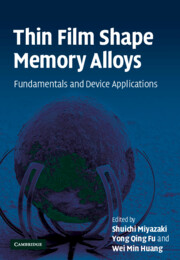Book contents
- Frontmatter
- Contents
- List of contributors
- Preface
- Abstracts of chapters
- 1 Overview of sputter-deposited TiNi based thin films
- 2 Martensitic transformation in TiNi alloys
- 3 Deposition techniques for TiNi thin film
- 4 TiNi multilayer thin films
- 5 Crystallization and microstructural development
- 6 Mechanical properties of TiNi thin films
- 7 Stress and surface morphology evolution
- 8 Ion implantation processing and associated irradiation effects
- 9 Laser post-annealing and theory
- 10 Overview of thin film shape memory alloy applications
- 11 Theory of SMA thin films for microactuators and micropumps
- 12 Binary and ternary alloy film diaphragm microactuators
- 13 TiNi thin film devices
- 14 Shape memory microvalves
- 15 Superelastic thin films and applications for medical devices
- 16 Fabrication and characterization of sputter-deposited TiNi superelastic microtubes
- 17 Thin film shape memory microcage for biological applications
- 18 Shape memory thin film composite microactuators
- 19 TiNi thin film shape memory alloys for optical sensing applications
- Index
17 - Thin film shape memory microcage for biological applications
Published online by Cambridge University Press: 23 February 2010
- Frontmatter
- Contents
- List of contributors
- Preface
- Abstracts of chapters
- 1 Overview of sputter-deposited TiNi based thin films
- 2 Martensitic transformation in TiNi alloys
- 3 Deposition techniques for TiNi thin film
- 4 TiNi multilayer thin films
- 5 Crystallization and microstructural development
- 6 Mechanical properties of TiNi thin films
- 7 Stress and surface morphology evolution
- 8 Ion implantation processing and associated irradiation effects
- 9 Laser post-annealing and theory
- 10 Overview of thin film shape memory alloy applications
- 11 Theory of SMA thin films for microactuators and micropumps
- 12 Binary and ternary alloy film diaphragm microactuators
- 13 TiNi thin film devices
- 14 Shape memory microvalves
- 15 Superelastic thin films and applications for medical devices
- 16 Fabrication and characterization of sputter-deposited TiNi superelastic microtubes
- 17 Thin film shape memory microcage for biological applications
- 18 Shape memory thin film composite microactuators
- 19 TiNi thin film shape memory alloys for optical sensing applications
- Index
Summary
Abstract
This chapter focuses on the fabrication and characterization of a microcage for biopsy applications. A microcage based on a free-standing film could be opened/closed through substrate heating with a maximum temperature of 90 °C, or Joule heating with a power less than 5 mW and a maximum response frequency of 300 Hz. A TiNi/diamond-like-carbon (DLC) microcage has been designed, analyzed, fabricated and characterized. The bimorph structure is composed of a top layer of TiNi film and a bottom layer of highly compressively stressed DLC for upward bending once it is released from the substrate. The fingers of the microcage quickly close through the shape memory effect once the temperature reaches the austenite transformation point to execute the gripping action. Opening of the microcage is realized by either decreasing the temperature to make use of the martensitic transformation or further increasing the temperature to use the bimorph thermal effect. The biocompatibility of both the TiNi and DLC films has been investigated using a cell-culture method.
Introduction
The wireless capsule endoscope (WCE) is a new diagnostic tool for searching for the cause of obscure gastrointestinal bleeding. A WCE contains video imaging, self-illumination, image transmission modules and a battery [1, 2]. The indwelling camera takes images and uses wireless radio transmission to send the images to a receiving recorder device that the patient wears around the waist. However, there are two drawbacks for the current WCE: (1) lack of ability for biopsy; and (2) difficulty in identifying the precise location of the pathology. Without tissue diagnosis, it is often difficult to differentiate inflammatory lesions from tumour infiltration.
- Type
- Chapter
- Information
- Thin Film Shape Memory AlloysFundamentals and Device Applications, pp. 403 - 425Publisher: Cambridge University PressPrint publication year: 2009



